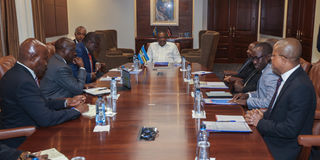DRC deserves a better deal

His Excellency President (Retired) Uhuru Kenyatta on Tuesday convened an urgent consultation with the EAC Technical Advisors to review the situation in eastern DRC.
On the map of Africa, the Democratic Republic of Congo (DRC) resembles a giant work of art rendered by a careless painter who allowed a huge blob of paint to flow southwards — almost dividing Zambia into two — and westwards, brutally tearing a wide gap between the Republic of the Congo (Brazzaville) and Angola.
Apparently, those who drew up boundaries during the Scramble for Africa had two aims. First, they did not want to leave the vast territory landlocked, and also, they wanted the all-important Congo River to have a free run to the Atlantic Ocean for the sole benefit of a Belgian tyrant.
Millions have died in that territory since the days of King Leopold II in the late 19th century. This is a man whose brutality towards Africans has been well-recorded in history.
To a certain extent, his ignoble exploits were to be replicated, a century later, by General Mobutu Sese Seko, whose long period of dictatorial misrule effectively sank the country into a deep economic quagmire from which it has never extricated itself, which is why, 26 years after his fall, Africans are still killing one another for virtually the same reasons: Unbridled lust for the country’s wealth.
The country’s vast mineral resources have always attracted capitalists from the West —and now from the East— like packs of hyenas sensing blood.
Gen Mobutu started his reign with the betrayal and execution of a great African nationalist, Patrice Lumumba, in 1961, a year after the country’s independence.
He became a ravenous puppet of the West, and eventually turned the country into his personal property, much like Leopold had done, destroying its economy with impunity until he was no longer useful to the neo-imperialists who had pulled the strings all along.
The tragedy about the DRC is that although it is a repository of great wealth, it is still one of the poorest countries on earth. Its minerals include copper, diamond, platinum, uranium, gold, zinc, manganese, silver, coal, oil, gas and rare earths like cobalt, lithium and palladium. It also boasts an inexhaustible supply of timber and other forestry resources, and could easily supply the rest of Africa with hydroelectricity if only it had the capacity. In this regard, it is highly ironic that the country is said to suffer greatly from unreliable power supply.
And this is not all that bedevils the DRC. Perhaps due to its huge size and the endless turmoil, the country has poor transport infrastructure, which has considerably contributed to its underdevelopment.
Disease and war
In fact, to this day, it has to rely on the Congo River as its major transport artery, which makes internal trading difficult. Even more unfortunate is the fact that, of its population — approximately 98 million souls — about 74 million are under 30 years, but many will die before 60 due to poverty, disease and war.
The country has never known peace since its independence in 1960. The nature of this miserable reality was brought home to us Kenyans when former President Uhuru Kenyatta was last October picked as the country’s envoy for the Great Lakes Region, and then in April this year, a contingent of Kenya Defence Force’s personnel was deployed to join those from other East African Community states in a regional force to keep the peace in the DRC.
The reason for the intervention by the East African Regional Force is simple. The eastern DRC region, which borders Rwanda, Uganda, Burundi, South Sudan and Tanzania, has always been volatile, a fact that has grave ramifications for those countries’ security that they can’t ignore. More than 200 militias reportedly operate in the area, waging war on government troops and on each other. Some of them, especially the formidable M23, behave like conventional armies, complete with uniforms and sophisticated weaponry, and are therefore a major security threat.
What is most worrying is that some of these militias are waging proxy wars against neighbouring countries on DRC soil and it is the ordinary civilians who routinely suffer massacres and displacement. This is the population the EARF is supposed to protect, though the Kinshasa government would rather it fought the militias. Consequently, relations between the EARF and the Kinshasa government are extremely low.
This is not all. This week, the Southern African Development Community also pledged to send troops to DRC. The countries, mainly South Africa, Angola, Zambia, Zimbabwe, Namibia and Tanzania, have not spelt out whether they are active or a peacekeeping force, a potentially dicey situation. When this happens, it will be an eerie echo of events between 1998 and 2003, when troops from Angola, Namibia and Zimbabwe descended on DRC to fight rebels backed by Uganda and Rwanda.
As a result, for one reason or the other, African countries have decided the DRC is too important to fail, though not all are convinced the only way to save it is to subdue the militias.
One hopes these forces will not start shooting at each other instead of restoring peace to this country which was described by Joseph Conrad in his 1899 novella as the “Heart of Darkness”. The poor Congolese deserve better than this.
Mr Ngwiri is a consultant editor; [email protected]





